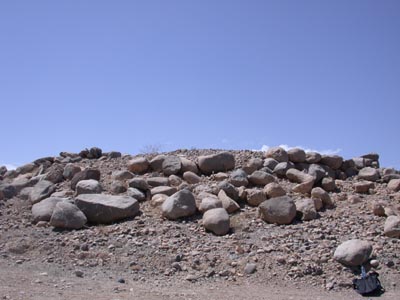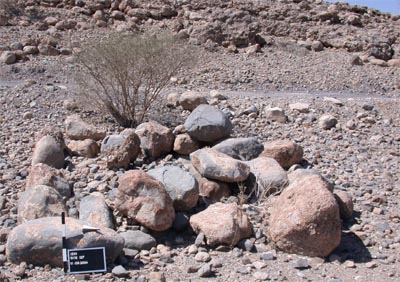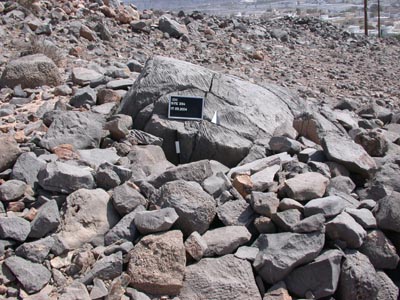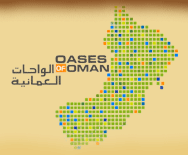Work package: Archaeological investigations in respect to the origin and development of oasis settlements in Oman
Contact Person: Dr. Jutta Häser, German Protestant Institute of Archaeology, Amman
Scientific staff and PhD students: Dr. Jutta Häser, Dr. Jürgen Schreiber, Dipl.-Ing. Martin Grosch, Frank Voigt, M.A.
Objectives: The research is focused on processes of transformation throughout history, regarding the architecture and material culture, the economy and ecology of the oasis settlements in a regional and interdisciplinary approach. The aim of the archaeological study is the investigation of the settlement in respect to their establishment and development as well as their ecological setting.
Study locations:
Archaeological survey at Izki in 2004
Izki is located in the upper part of Wadi Halfayn, directly at the southern end of the Sumail-gap which is one of the most important passages through the Al Hajar mountains. It connects the coastal Batinah with the interior of Central Oman.
The oasis of Izki is divided into several quarters and settlement areas. The oldest traditional quarters are al-Yaman and al-Nizar which are separated by a c. 200 years old fort dividing the two formerly rival tribes. To the north, the settlements Seddi, Maghiouth, and Harat al-Raha can be found, to the west, the settlements Wuddai and Harat Bani Husain, and to the south some small villages extending to the settlement of Zukait.
According to local tradition, Izki is the oldest town in Oman. Here, Malik bin Fahm should has settled with the Azd tribe after their emigration from Yemen. Another tradition mentions Izki as a place where the idol Junan should have been worshipped in pre-Islamic times.
Additionally, Izki is important since it is the only town in Oman which is probably mentioned in cuneiform texts. According to an inscription on the so-called Ishtar-slab – found in Niniveh in and dated to c. 640 B.C. – a king named Padê from the town Is / / z - ki/ qi-e payed tribute to Ashurpanipal, king of Assyria, after a half years journey to the royal court at Niniveh.
Only few archaeological investigation have been carried out before our overall survey of the oasis (Costa 1988).
More than 1000 archaeological sites were recorded during the survey in 2004. Most of them were tombs. The oldest remains can be dated to the Hafit period (late 4th-early 3rd millennium B.C.). About 250 Hafit tombs could be recorded.
The oldest settlement remains are dated by pottery to the Umm an-Nar period (3rd millennium B.C.). It is marked by a round structure at Saruj and a settlement with house structure about 100 m to the south. Interestingly, no Umm an-Nar tombs were found.

Round structure of the Umm an-Nar period close to Saruj
© 2004 DAI Orient-Abteilung Berlin
Like at many other places in Oman, remains of the Wadi Suq period are very scarce. In Izki only some sherds found in Hafit tombs prove the use of this are by people in the 2nd millennium B.C.
A larger number of sites could be dated to the Early Iron Age (1000-600 B.C.). The settlement of the Umm an-Nar period was re-used. Another settlement of this period is situated on the eastern side of the Wadi Halfayn at Magiouth. Very obvious is the increase in cemeteries and the number of secondary burials in Hafit tombs.

So-called Izki-Tomb © 2004 DAI Orient-Abteilung Berlin
The Late Iron Age or Samad period (300 B.C.-900 A.D.) is represented especially by tombs but some sherds of this period were found in the area of the old town of Izki. It is very probable that a Late Iron Age settlement was established at this place, because it is the best place for settling in the entire area of the modern oasis.

Tomb of the Late Iron Age © 2004 DAI Orient-Abteilung Berlin
Only few sites of the Early Islamic period could be registered. This could be due to the difficulties of recognizing the specific Early Islamic material in comparison to the Late Iron Age material. More sites of Middle Islamic date could be proved. A clear increase of settlement activities and the development of the oasis to its pre-modern extension took place in the Late Islamic period.
Support
The archaeological project was financed by the German Institute of Archaeology, the Sultan Qaboos University Muscat and the German Research Foundation.
Publications
| |
Costa, P. M. 1988. Pre-Islamic Izki: Some Field Evidence, Proceedings of the Seminar for Arabian Studies 18, 15-23.
|
|
Potts, D. 1985, The location of Iz-ki-e, Revue d’Assyriologie 79, 75-76.
|
 |
Schreiber, J. 2004. Archaeological reconnaisance at Izki and the Jebel Akhdar. Transformation processes of oasis settlement in Oman 2004 - third stage. A preliminary report. Occident & Orient 9, 6-11.
|
 |
Schreiber, J. 2005. Jahresbericht der Orient-Abteilung 2004: Oman. Archäologischer Anzeiger 2004, 249-251.
|
 |
Schreiber, J. 2007. Transformationsprozesse in Oasensiedlungen Omans. Die vorislamische Zeit am Beispiel von Izki, Nizwa und dem Jebel Akhdar. PhD-thesis
|
| |
|
© Jutta Häser
|




